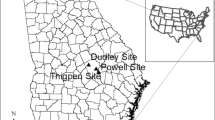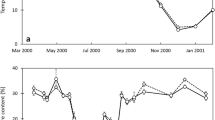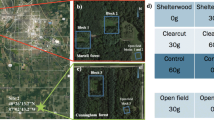Abstract
Recovery of longleaf pine (Pinus palustris P. Mill.) is necessary to arrest the decline of many associated plants and animals, and the establishment of longleaf pine on much of its original range requires artificial regeneration and diligence. In central Louisiana, USA, two fertilization levels (No [NF] or Yes [F-36 kg/ha N and 40 kg/ha P]) in combination with three vegetation treatments (check, two prescribed fires [PF], or multi-year vegetation control by herbicidal and mechanical means [IVM]) were applied to container-grown longleaf pine plantings in two studies. In Study 1 (grass dominated), 6-year-old longleaf pine survival was 52% on the F–checks, 78% on the F–PF plots, and averaged 93% on the other four treatment combinations. Longleaf pine trees on the IVM plots (3.4 m) were significantly taller than on the other two vegetation treatments, and trees on the PF plots (1.8 m) were taller than trees on the check plots (1.2 m). In Study 2 (brush dominated), survival averaged 65% across the six-treatment combinations after 6 years. The longleaf pine trees were 4.7 m tall on the IVM plots and averaged 3.9 m tall on the check and PF plots. Fertilization increased P concentrations in the soil and longleaf pine foliage, while fertilization did not significantly affect longleaf pine height growth. Native fertility was not apparently limiting longleaf pine development contrary to prior research recommendations for these soils. In both studies, the IVM treatment reduced early herbaceous competition and the number and height of arborescent plants. The PF treatment reduced arborescent plant height on the grassy site where fires were more intense than on the brushy site.





Similar content being viewed by others
References
Barnett JP (1989) Site preparation, containers, and soil types affect field performance of loblolly and longleaf pine seedlings. Proc Bienn South Silvic Res Conf 5:155–158
Barnett JP, Dumroese RK, Moorhead DJ (eds) (2002) Proc: Workshops on growing longleaf pine in containers—1999 and 2001. USDA For. Serv., South. Res. Sta., Asheville, North Carolina. Gen. Tech. Rep. SRS-56
Blevins D, Allen HL, Colbert S, Gardner W (1996) Nutrition management for longleaf pinestraw. Woodland Owners Notes No. 30, NC State University, North Carolina Cooperative Extension Service, Raleigh, 8 p
Boyer WD (1983) Growth of young longleaf pine as affected by biennial burns plus chemical or mechanical treatments for competition control. Proc Bienn South Silvic Res Conf 2:62–65
Boyer WD, Miller JH (1994) Effect of burning and brush treatments on nutrient and soil physical properties in young longleaf pine stands. For Ecol Manage 70:311–318
Brockway DG, Outcalt KW (2000) Restoring longleaf pine wiregrass ecosystems: hexazinone application enhances effects of prescribed fire. For Ecol Manage 137:121–138
Brockway DG, Outcalt KW, Wilkins RN (1998) Restoring longleaf pine wiregrass ecosystems: plant cover, diversity and biomass following low-rate hexazinone application on Florida sandhills. For Ecol Manage 103:159–175
Bruce D (1951) Fire, site, and longleaf height growth. J For 49:25–28
Burton JD (1984) A continuous function approach to measuring response of young pine plantations to rates of application of nitrogen and phosphorus fertilizers. II longleaf pine on Ruston and Lucy soils. Establishment Rep. FS-S0–1102–7.10. USDA For. Serv., South. For. Exp. Sta., Pineville, Louisiana
Cordell CE, Anderson RL, Kais AJ (1989) How to identify and control brown-spot disease on longleaf pine. USDA For. Serv., South. Region, Atlanta, Georgia Protection Rep. R8-PR 15
Croker TC, Jr. (1987) Longleaf pine a history of man and a forest. USDA For. Serv., South. Region, Atlanta, Georgia Forestry Rep. R8-FR 7
Croker TC Jr, Boyer WD (1975) Regenerating longleaf pine naturally. USDA For. Serv., South. For. Exp. Sta., New Orleans, Louisiana, Res. Pap. SO-105
Derr HJ (1957) Effects of site treatment, fertilization, and brownspot control on planted longleaf pine. J For 55:364–367
Grelen HE (1983) May burning favors survival and early height growth of longleaf pine seedlings. South J Appl For 7:16–20
Hardin ED, White DL (1989) Rare vascular plant taxa associated with wiregrass (Aristida stricta) in the southeastern United States. Nat Areas J 9:234–245
Haywood JD (1995) Prescribed burning and hexazinone herbicide as release treatments in a sapling hardwood-loblolly pine stand. New For 10:39–53
Haywood JD (2000) Mulch and hexazinone herbicide shorten the time longleaf pine seedlings are in the grass stage and increase height growth. New For 19:279–290
Haywood JD (2002) Delayed prescribed burning in a seedling and sapling longleaf pine plantation in Louisiana. Proc Bienn South Silvic Res Conf 11:103–108
Haywood JD (2005) Effects of herbaceous and woody plant control on Pinus palustris growth and foliar nutrients through six growing seasons. For Ecol Manage 214:384–397
Haywood JD, Grelen HE (2000) Twenty years of prescribed burning influence the development of direct-seeded longleaf pine on a wet pine site in Louisiana. South J Appl For 24:86–92
Haywood JD, Tiarks AE (1990). Eleventh-year results of fertilization, herbaceous, and woody plant control in a loblolly pine plantation. South J Appl For 14:173–177
Haywood JD, Harris FL, Grelen HE (2001) Vegetative response to 37 years of seasonal burning on a Louisiana longleaf pine site. South J Appl For 25:122–130
Jose S, Merritt S, Ramsey CL (2003) Growth, nutrition, photosynthesis and transpiration responses of longleaf pine seedlings to light, water and nitrogen. For Ecol Manage 180:335–344
Kais AG, Cordell CE, Affeltranger CE (1986) Benomyl root treatment controls brown-spot disease on longleaf pine in the southern United States. For Sci 32:506–511
Kerr A Jr, Griffis BJ, Powell JW, Edwards JP, Venson RL, Long JK, Kilpatrick WW (1980) Soil survey of Rapides Parish, Louisiana. USDA Soil Conserv. Serv. and For. Serv., in cooperation with Louisiana State Univ., Louisiana Agric. Exp. Sta., Alexandria, Louisiana, 87 p
Lewis CE (1977) Longleaf pine responds through age 15 to early fertilization. USDA For. Serv., Southeast. For. Exp. Sta., Asheville, North Carolina Res. Note SE-239
Louisiana Office of State Climatology (2002) Louisiana monthly climate review. Southern Regional Climate Center, Depart. Geography and Anthropology, Louisiana State Univ., Baton Rouge 22:1–126
Loveless RW, Pait JA III, McElwain T (1989) Response of longleaf pine to varying intensity of silvicultural treatments. Proc Bienn South Silvic Res Conf 5:159–164
McNab WH, Avers PE (comps) (1994) Ecological subregions of the United States: section descriptions. USDA For. Serv., Washington Off. Admin. Pub. WO-WSA-5
Nelson LR, Zutter BR, Gjerstad DH (1985) Planted longleaf pine seedlings respond to herbaceous weed control using herbicides. South J Appl For 9:236–240
Outcalt KW (1993) Southern pines performance on sandhills sites in Georgia and South Carolina. South J Appl For 17:100–102
Outcalt KW, Sheffield RM (1996) The longleaf pine forest: trends and current conditions. USDA For. Serv., South. Res. Sta., Asheville, North Carolina. Resource Bull. SRS-9
Ramsey CL, Jose S (2004) Growth, survival and physiological effects of hexazinone and sulfometuron methyl applied overtop of longleaf pine seedlings. South J Appl For 28:48–54
Ramsey CL, Jose S, Brecke BJ, Merritt S (2003) Growth response of longleaf pine (Pinus palustris Mill.) seedlings to fertilization and herbaceous weed control in an old field in southern USA. For Ecol Manage 172:281–289
SAS Institute Inc. (1985) SAS User’s guide: statistics. 5th ed. SAS Institute Inc., Cary, North Carolina, 956 p
Schmidtling RC (1987) Relative performance of longleaf compared to loblolly and slash pines under different levels of intensive culture. Proc Bienn South Silvic Res Conf 4:395–400
Shoulders E (1985) The case for planting longleaf pine. Proc Bienn South Silvic Res Conf 3:255–260
Steel RGD, Torrie JH (1980) Principles and procedures of statistics a biometrical approach, 2nd edn. McGraw-Hill Book Company, New York, 633 p
Tiarks AE (1983) Effects of site preparation and fertilization on slash pine growing on a good site. Proc Bienn South Silvic Res Conf 2:34–39
Turner RL, Van Kley JE, Smith LS, Evans RE (1999) Ecological classification system for the national forests and adjacent areas of the West Gulf Coastal Plain. The Nature Conservancy, Nacogdoches, Texas, 305 p
Wahlenberg WG (1946) Longleaf pine its use, ecology, regeneration, protection, growth, and management. Charles Lathrop Pack Forestry Foundation and USDA For. Serv., Washington, DC, 429 p
Waldrop TA, White DL, Jones SM (1992) Fire regimes for pine-grassland communities in the southeastern United States. For Ecol Manage 47:195–210
Author information
Authors and Affiliations
Corresponding author
Rights and permissions
About this article
Cite this article
Haywood, J.D. Influence of herbicides and felling, fertilization, and prescribed fire on longleaf pine establishment and growth through six growing seasons. New Forests 33, 257–279 (2007). https://doi.org/10.1007/s11056-006-9026-3
Received:
Accepted:
Published:
Issue Date:
DOI: https://doi.org/10.1007/s11056-006-9026-3




